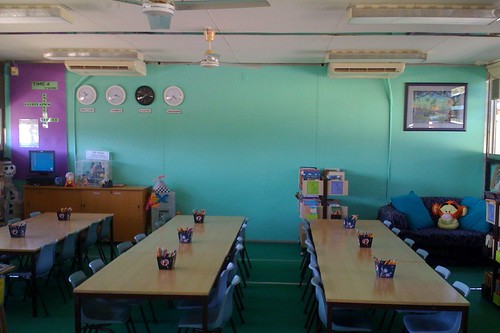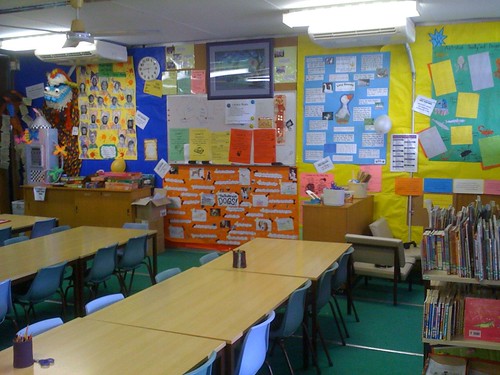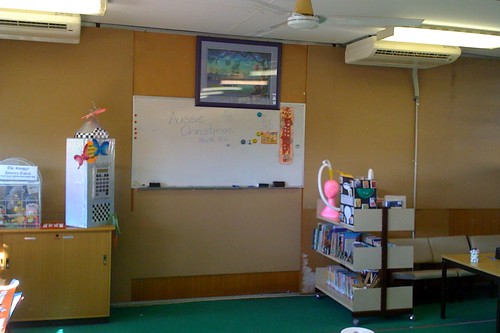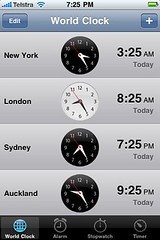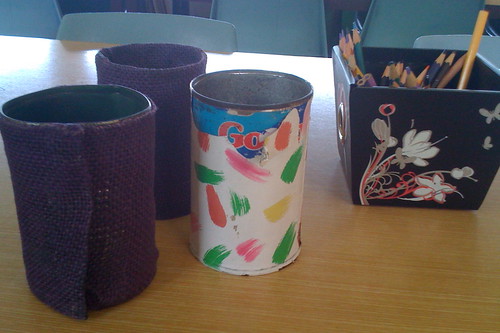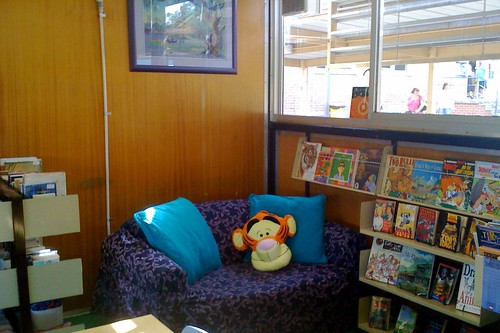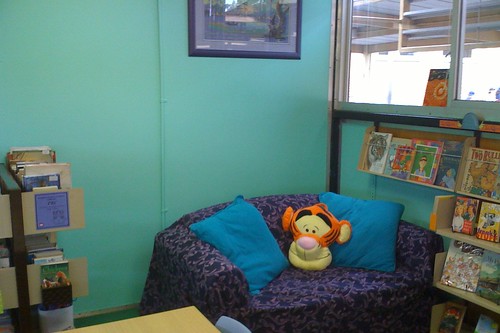You know what? This has been the hardest blog entry to write – ever!
I completed the paint job on the back wall on Thursday afternoon, hung around after school for the paint to be dry enough to remove the masking tape from all the edges, re-adjust the couch’s purple cover and push all the furniture back into position, and then had to head into the city. Although I was exhausted from Wednesday’s undercoating (mineral turps cleanup, ugh!) and the Thursday’s two coats of semi-gloss (water-based), I did have photos to share, but something was stopping me.
Here it is Sunday afternoon already, and I’m still dragging the chain. Since this is probably the end of the current wave of shoestring makeovers, and normal classes start in the library on Monday, maybe I’ve become too attached to the renovation process? But I must… share! 😉
Why green? Well, I picked an obviously contrasting colour from the beautiful purple-framed Kim Gamble artwork I’d decided to decorate around. And our carpet is already the medium green school carpet. The Taubman’s Living Proof Silk green paint tint is actually called “Coral Fantasy”. The closest match I found to the existing purple frame, in case I need to paint anything purple in the future, is called “Tyrian Purple”.
In any case, the back wall started like this:
and ended up like this:
Some plants, both artificial and natural are still to come, but… I’m sooooooo ready for that IWB to arrive!

NEW YORK, LONDON, PENRITH, AUCKLAND.
I loved the “newsroom clocks” idea, from a secondary school renovation in Kevin Hennah’s presentation last year, and I wondered if it was appropriate for a primary school. Or just too confusing? On my visit to Spotlight last year, I bought MDF letters for the signage on the opposite wall. When price-checking my purchases at the nearby rival store, Lincraft, I noticed they had three large white clocks on special for just $9.95 each. I’d already figured I needed four. Then I noticed they had a few of the same model in black – but again, not four. Brainstorm! I realised: even students who can’t read should be able to tell that “Penrith” time is on the black clock! (Well, okay, if they can’t read they probably also can’t tell the time, but you get the idea!)
By the way, my iPhone has a “world clocks” application, which I have adjusted to match the order of the library clocks!
This was my Friday afternoon very-shoestring solution to a problem. When the school assistant helped me remove all the pinboards that were covering this wall, this last one was not able to be unscrewed, because the school’s burglar alarm system is bolted through the board. I did intend this section to have some MDF letters, perhaps in purple, to spell out our four core values, but I was also concerned I was going overboard with MDF lettering. Could I perhaps try a more economical piece of signage on the laminator, as a placeholder until it’s proven the area needs something more permanent?
On top of this, people kept asking me if Kevin Rudd was giving us a brand new library, and therefore why was I still redecorating the old one? So, anyway, here’s my quick solution: purple cardboard to cover the annoying old pinboard, and some laminated core values. The “TIME 4 learning” at the top is a small version of what I planned to have, as a vinyl-lettering-on-3D-perspex sign, under the four clocks. Until the IWB arrives, I really don’t want to tempt fate. Yet.
Note the white “Library rules” sign, which we made last year on our special library signage template. On Friday I also took down the matching “Closed for stocktake” signs. There are also red, green and purple “Premier’s Reading Challenge” laminated signs in appropriate places.
Oh, and the new coloured-pencil containers on the desks? I figured those old hessian- and/or Contact-covered cat-food tins from the 70s had outlived their usefulness. The new Accent Concepts containers (below right) are $3 each, in both purplish-blue and black, (and a pinkish shade for lead pencils). From Hot Dollar:
And the couch corner goes from this:
My special thanks to parent helper, Laura, who braved what is now known as Thickening Paint Thursday, – especially when we had to turn off the two nearest air conditioners because condensation was running down the outside of the ugly conduits we were so desperate to disguise the same green colour as the wall to which they were screwed!

